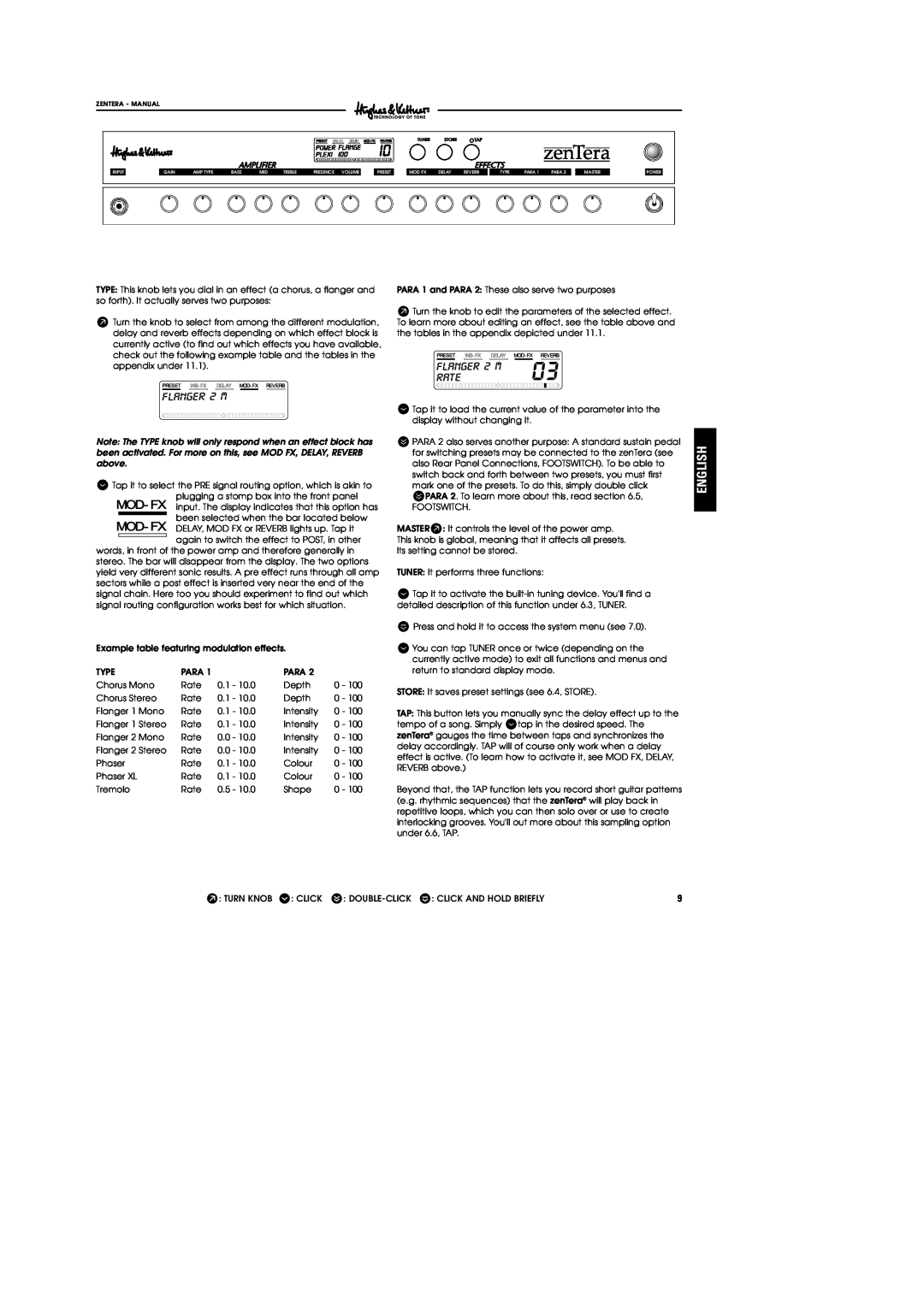
ZENTERA - MANUAL
|
|
|
|
|
|
|
| TUNER | STORE |
|
|
|
|
|
|
INPUT | GAIN | AMP TYPE | BASS | MID | TREBLE | PRESENCE VOLUME | PRESET | MOD FX | DELAY | REVERB | TYPE | PARA 1 | PARA 2 | MASTER | POWER |
TYPE: This knob lets you dial in an effect (a chorus, a flanger and so forth). It actually serves two purposes:
WTurn the knob to select from among the different modulation, delay and reverb effects depending on which effect block is
currently active (to find out which effects you have available, check out the following example table and the tables in the appendix under 11.1).
Note: The TYPE knob will only respond when an effect block has been activated. For more on this, see MOD FX, DELAY, REVERB above.
rTap it to select the PRE signal routing option, which is akin to plugging a stomp box into the front panel
input. The display indicates that this option has been selected when the bar located below
DELAY, MOD FX or REVERB lights up. Tap it again to switch the effect to POST, in other
words, in front of the power amp and therefore generally in stereo. The bar will disappear from the display. The two options yield very different sonic results. A pre effect runs through all amp sectors while a post effect is inserted very near the end of the signal chain. Here too you should experiment to find out which signal routing configuration works best for which situation.
Example table featuring modulation effects.
TYPE | PARA 1 |
| PARA 2 |
|
Chorus Mono | Rate | 0.1 - 10.0 | Depth | 0 - 100 |
Chorus Stereo | Rate | 0.1 - 10.0 | Depth | 0 - 100 |
Flanger 1 Mono | Rate | 0.1 - 10.0 | Intensity | 0 - 100 |
Flanger 1 Stereo | Rate | 0.1 - 10.0 | Intensity | 0 - 100 |
Flanger 2 Mono | Rate | 0.0 - 10.0 | Intensity | 0 - 100 |
Flanger 2 Stereo | Rate | 0.0 - 10.0 | Intensity | 0 - 100 |
Phaser | Rate | 0.1 - 10.0 | Colour | 0 - 100 |
Phaser XL | Rate | 0.1 - 10.0 | Colour | 0 - 100 |
Tremolo | Rate | 0.5 - 10.0 | Shape | 0 - 100 |
PARA 1 and PARA 2: These also serve two purposes
WTurn the knob to edit the parameters of the selected effect. To learn more about editing an effect, see the table above and
the tables in the appendix depicted under 11.1.
rTap it to load the current value of the parameter into the display without changing it.
sPARA 2 also serves another purpose: A standard sustain pedal for switching presets may be connected to the zenTera (see
also Rear Panel Connections, FOOTSWITCH). To be able to switch back and forth between two presets, you must first
mark one of the presets. To do this, simply double click
sPARA 2. To learn more about this, read section 6.5,
FOOTSWITCH.
MASTERW: It controls the level of the power amp. This knob is global, meaning that it affects all presets. Its setting cannot be stored.
TUNER: It performs three functions:
rTap it to activate the
tPress and hold it to access the system menu (see 7.0).
rYou can tap TUNER once or twice (depending on the currently active mode) to exit all functions and menus and
return to standard display mode.
STORE: It saves preset settings (see 6.4, STORE).
TAP: This button lets you manually sync the delay effect up to the tempo of a song. Simply rtap in the desired speed. The zenTera® gauges the time between taps and synchronizes the delay accordingly. TAP will of course only work when a delay effect is active. (To learn how to activate it, see MOD FX, DELAY, REVERB above.)
Beyond that, the TAP function lets you record short guitar patterns (e.g. rhythmic sequences) that the zenTera® will play back in repetitive loops, which you can then solo over or use to create interlocking grooves. You'll out more about this sampling option under 6.6, TAP.
ENGLISH
W: TURN KNOB r: CLICK s: | 9 |
